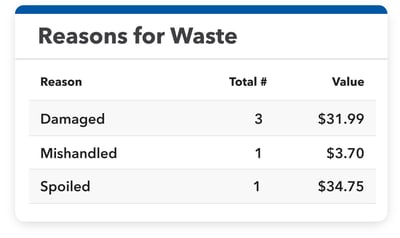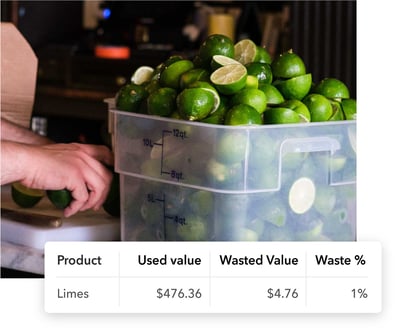Waste not, want not: how technology is reshaping the fight against food waste in restaurants
Food waste is an increasingly pervasive problem, and we’re not just talking about kids refusing to eat their crusts. Nearly 40% of all the food in the U.S. goes to waste every year. That's a mind-boggling 119 billion pounds, amounting to over $408 billion down the drain. This wasteful trend isn't confined to our homes; it's happening in restaurants too.
While some of this waste happens at the manufacturing and retail levels, Mother Nature isn’t helping the issue. Historic heat waves, droughts, fires, floods and other weather events are decimating crops. Georgia, the Peachtree State, has lost close to 90% of its peach harvest this year, while California’s tomato fields lay soggy from record rains. Throw in a good dose of inflation and it isn’t just consumers with a problem in their wallets.
When it comes to restaurants, the Department of Agriculture estimates that food waste at the retail and consumer level accounts for $162 billion in loss. Sure, some waste is inevitable – you can't always predict when a steak might take an unexpected nosedive onto the kitchen floor. But, unchecked waste can be a real blight for a restaurant’s bottom line.
Thankfully, technology has drastically improved to help tackle this age-old problem. In the world of restaurants, where every dollar counts, these new digital tools are no longer nice-to-haves but downright necessities. The strongest tool for managing waste in a restaurant’s tech stack is a Restaurant Management System (RMS). These systems are like having a watchful guardian over your kitchen. Here are four ways RMSs are transforming the restaurant industry's battle against food waste.
4 ways restaurant technology is reshaping the fight against food waste
Spilling the T(rash) - Waste logs
To start, RMSs digitize invoices to track everything coming into your kitchen and integrate with your Point of Sale (POS) so they know what you’ve sold. When you combine this with tracking inventory on-hand amounts and a waste log, you’ve got a near real-time, complete picture of food costs, Prime Costs (when you integrate labor) and even a daily P&L.
As a key feature, waste logs are crucial for recording both raw and completed waste, such as vegetable trimmings or half-eaten plates, what kind of waste occurred and which staff member is responsible. You can track and digitally record where and when waste is happening on a daily basis.
Did a batch of guacamole not get used and need to be thrown out at the end of the day? Muscle memory kicked in so Chef forgot their guest asked for sauce on the side, resulting in a wasted plate? Extracting crab meat and leaving ten percent in the shell or cutting a filet of salmon to nine ounces instead of eight ounces adds ten percent to your target food usage (and cost). Maybe over-portioning the protein by an ounce or two doesn’t seem like a big deal to your staff but a quick look at your sales to see 200 burgers or sea bass times two ounces times 300 days a year can add up quickly.

An RMS enables you to pinpoint these issues and take corrective action. It shows you your biggest reasons for waste (mishandling, end-of-day waste, etc.) as well as items that generated the biggest hit to your bottom line, so you can make changes immediately – not when it’s too late.
This data isn't just a digital paper trail; it's a tool for better training, employee accountability and operational efficiency.
AvT, as easy as 1, 2, 3 – Actual versus theoretical cost variance
Another key piece of RMS technology to combat waste is being able to see actual vs. theoretical (AvT) food cost variance data at a glance. Traditionally, many operators record these values on spreadsheets, spending hours manually updating inventory counts, order amounts and sales data. With an RMS, this is all computed automatically, so instead of typing in numbers and hoping you didn’t make a mistake, you can very quickly see near real-time variance amounts.

Combining AvT variance and waste log tracking gives an even more accurate picture of where waste is happening in your restaurant. Say for instance you see there’s a 10% AvT variance for ribeye steaks. A pricey product, you can’t afford to be off target with food costs by more than 2-3%. With AvT alone, you know at least something is going on with ribeyes and where to direct your efforts to lessen the waste. With waste log tracking, this issue is illuminated even more.
Is the large variance accounted for because of prep and trim recorded in your waste log? If so, you can talk to your chefs about it or train them on proper trimming techniques. Is it because the ribeyes are being mishandled? Time to check your thermometers or ask your wait staff to make sure guests know what “medium” versus “medium-well” means. And if the waste log doesn’t explain the AvT variance, you know the problem isn’t likely in your kitchen so you can start investigating elsewhere.
It counts to count – Inventory management

Taking inventory in a restaurant is a must, no two ways about it. But it's not just about tracking what's been ordered and what you’ve sold. It's about knowing what's hanging out in the back, what condition it’s in and whether it's reaching its use-by date. Regular inventory checks ensure that products are stored correctly, adhere to the 'first-in, first-out’ (FIFO) rule, and stay within their prime. And hey, it's also a great way to avoid that uncomfy adrenaline rush when the health inspector unexpectedly drops by.
Imagine you run a bustling Mexican restaurant known for its legendary margaritas, so naturally, you buy a ton of limes. With a steady stream of cases coming in and a decent stockpile building (lessons learned from the citrus shortage of 2022), you need a way to make sure your investment won’t turn sour.
Thanks to regularly tracking your inventory with an RMS, you discover that out of every three cases of limes, one ends up partially spoiled. If buying a half-case less is cost-prohibitive, you can juice that extra half-case while they’re still fresh and freeze the juice in quart containers until you need it. With a keener eye on your inventory, your team will use the ripest perishables first and find ways to make use of what’s on its last leg to cut down on waste.
Got a few extra gallons of milk approaching their expiration date? Transform them into a delectable dulce de leche dessert special. Remember, if it's on the shelves, it's been paid for, so get creative and recoup those costs!
If you’re short on staff or feel like you’ve got a good thing going with big, four-hour, end-of-the-month full inventories, RMSs allow you to still reap the benefits of frequent counts with less effort. Since your RMS knows everything you purchase thanks to the info from your invoices, you can very quickly see the top five products you spend the most money on and focus on counting those more regularly. .jpg?width=600&height=400&name=Smokecraft_0603-600x400-bf06395%20(2).jpg)
Why sweat over counting every spice when you can concentrate on what really matters to your wallet? It’s an easy hack that keeps you informed and streamlines your waste-tracking efforts.
With an RMS, you can work smarter, not harder, and keep your kitchen humming efficiently.
A data-backed gut - Prediction and AI
AI-based tech is starting to emerge in the restaurant industry, promising to manage tasks ranging from drone take-out deliveries to predictive ordering. While the technology is still new, it's likely that RMSs will soon be at the forefront of these systems to make running restaurants even more efficient.
What might the future look like? Since RMSs track your ordering, inventory and sales data from your POS, it’s possible that RMSs will be able to tell you exactly how much of each product to order every week given historical patterns. This is incredibly exciting in concept, but the reality is a little bit more complicated.
As any operator knows, there are common repeatable patterns you can use to predict order amounts for the week (like Friday nights and Saturday nights are usually busier than a Wednesday night for Full Service restaurants). This is usually a skill honed from years of experience and going by your gut. But as good as your gut is, anything from sudden bad weather to major political events can change it all.
Until the day comes when you can press a button and order the exact amount of food you need resulting in zero (or close to zero) unused product, RMSs are still an essential tool for combating waste thanks to their integration with your POS.
Sales data can be easily viewed from your RMS, quickly showing your historical sales performance so you can make data-based decisions about how much to order. Maybe you feel like your sales tend to slow down after Labor Day because you’re in a touristy area. With an RMS, you’ll be able to check your sales performance and pinpoint which week things start to change so you can start ordering fewer products and hopefully end up with less waste.
With RMS menu analysis modules you can also gut-check which specific menu items are performing the best and which ones aren’t. You might think everyone loves Grandma Betty’s liver toast recipe, but you notice there’s quite a bit of liver on the waste log each week because it goes bad. By checking your RMS to see how well that menu item performs compared to your other appetizers, you can see that it just isn’t selling like you thought it would.
Armed with this insight, you can tweak your menu, adjust portion sizes or change your ordering patterns to minimize waste and maximize profits. An RMS likely won’t replace that deeply skilled gut instinct just yet, but it does give you the insights to make data-backed decisions that help to effectively cut down on waste today.
As technology continues to revolutionize the restaurant industry, RMS solutions are becoming indispensable allies in the fight against food waste. These systems offer practical insights, streamlined operations and a pathway to a more sustainable and prosperous future for restaurants. So, as we ride the tech wave, we're not just cutting down on waste; we're reshaping how restaurants operate, paving the way for a more profitable, responsible and conscious culinary world.


![[Download Now]: Free Food Waste Log Template](https://no-cache.hubspot.com/cta/default/6423873/f0aa82e2-57f4-4d32-913b-5e4d60b21e78.png)
